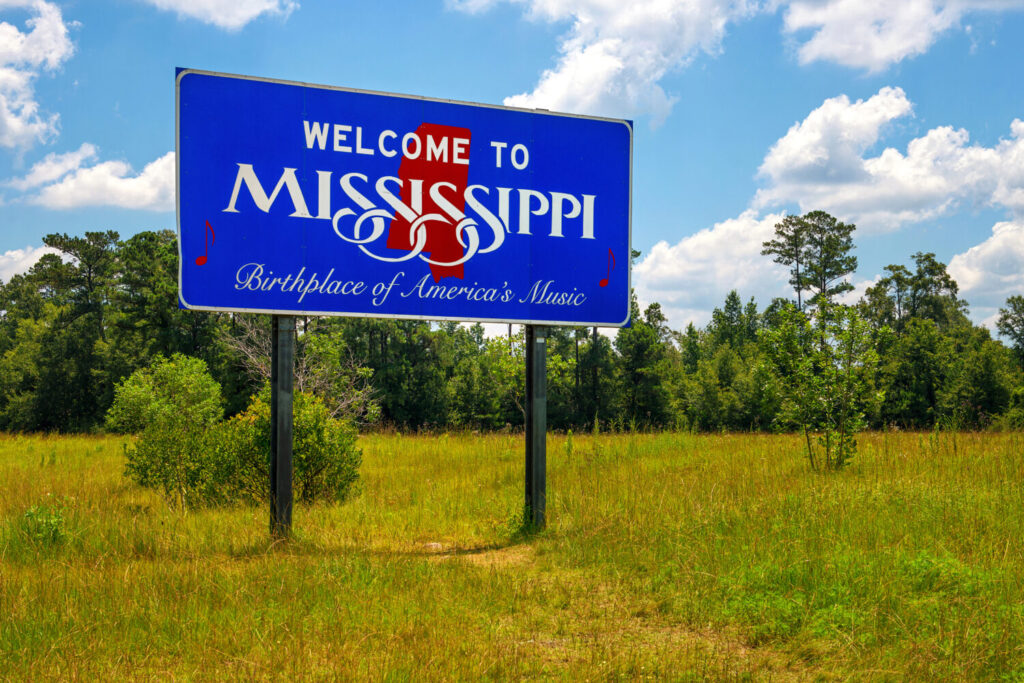How Tall Is Mississippi? Total Distance North to South
Key Points
- Mississippi is the 32nd-largest state in the United States by area
- It became the 20th U.S. state when it was admitted into the Union in 1817
- Mississippi’s geography consists of lowland forests, wetlands, and plains
- The state is home to many fascinating animals, including alligators and migratory birds
How tall is Mississippi? This article explores Mississippi’s height, as well as its history, geography, and wildlife. Additionally, it explores how Mississippi’s height compares to other states.
How Tall Is Mississippi?
Mississippi is one of the smaller states in the U.S. It is larger in height than in width, appearing as a tall rectangle with a boot heel in the southeastern corner. Mississippi measures 332 miles tall from north to south. As for width, .
Overall Size of Mississippi

©Ingo70/Shutterstock.com
Mississippi is 48,430 square miles in total area, making it the 32nd-largest state in the U.S. 46,952 square miles of its total area are land, and 1,521 are water. This means Mississippi is 3% water.
How Mississippi Compares to Other States
Let’s explore how tall Mississippi is compared to other states. First, let’s look at how it compares to the tallest state. , measuring 1,420 miles from north to south. That’s a whopping 1,088 miles taller than Mississippi! In fact, Alaska is over four times taller than Mississippi.
Next, let’s compare Mississippi to the shortest state in the U.S. At just 42 miles from north to south, Rhode Island is the shortest. That means Mississippi is 290 miles longer than Rhode Island! In fact, Mississippi is nearly eight times taller than Rhode Island
Finally, let’s see how Mississippi compares to its neighbors. Its tallest neighbor is Florida, measuring 447 miles from north to south. That’s 115 miles taller than Mississippi. For another comparison, Mississippi’s shortest neighbor is Tennessee. It measures 120 miles from north to south. That means Mississippi is 212 miles taller than Tennessee. As for Mississippi’s three other neighbors, they all are fairly similar in height to Mississippi. Louisiana is 379 miles tall, which is just 47 miles taller than Mississippi. Arkansas is 240 miles tall, which is 92 miles shorter than Mississippi.
Finally, Alabama is 330 miles tall, which is just 2 miles shorter than Mississippi. The two states are extremely similar in size and shape, and their outlines look like a mirror image of one another.
Becoming Part of the United States

©iStock.com/rarrarorro
According to the Library of Congress, . However, Mississippi’s history stretches much further back. Humans have lived in what is now called Mississippi since around 10,000 BCE. Over thousands of years, the Mississippian culture developed, which was an early agricultural civilization. The and people, who are indigenous peoples from Mississippi, are descendants of the Mississippian culture.
France began settling the Gulf Coast of Mississippi in 1699. The French brought enslaved Africans to the region and established plantations. Then in 1763, after the French and Indian War, Britain took control of the region via the Treaty of Paris. After the American Revolutionary War, the United States gained control of Mississippi and it was admitted into the Union as the 20th state in 1817. By 1860, Mississippi was the largest cotton producer of any U.S. state and its population was 50% enslaved people.
In 1861, Mississippi became the second state to secede from the Union following South Carolina. This led to the American Civil War, in which the Confederate States of America and the Union battled over whether to allow slavery in the western territories of the United States. In 1865, Confederate General Robert E. Lee surrendered, ending slavery in the Confederacy and reuniting the country. Mississippi became the final state to remove the Confederate battle flag from its official state flag in 2021.
Geography of Mississippi
Mississippi’s geography includes vast river deltas, wetlands, forests, and the Gulf Coast. The state is most famous for the massive which runs along its western border and forms the massive Mississippi Delta. Additionally, the Gulf Coast features a vast coastal plain. Mississippi is primarily lowlands, with .
Wildlife in Mississippi

©FotoRequest/Shutterstock.com
Due to its rivers and coastal plains, Mississippi is home to some incredible animals, including migratory birds. One of the most common animals in Mississippi is the , the . The state is also known for its massive , which live in its rivers, lakes, and swamps.
Additionally, there are at least 426 species of birds that live in Mississippi. The state is a final destination on the Mississippi Flyway, a migratory bird route that runs from Canada to the Gulf of Mexico. A couple of incredible species that migrate through Mississippi are the and the whooping crane. In addition to migratory birds, Mississippi is also home to an abundance of songbirds. Some of the most common species are the , American goldfinch, and house sparrow.









